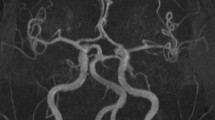Summary
Seven adult patients, 4 males and 3 females aged from 32 to 41 years, suffering from a new hereditary disease characterized by progressive dementia and polycystic osteodysplasia were studied neuroradiologically. Pneumoencephalography revealed diffuse generalized atrophy both in the supratentorial and infratentorial spaces, consisting of central periventricular brain tissue, cortex, and brain stem. The atrophy was most striking in the frontal and parietal areas. In one case, intracranial calcifications were found in the basal ganglia. Carotid angiography, performed in one case, did not reveal any changes indicative of a vascular origin. There appears to be a remarkably positive correlation between the degrees of clinical and PEG findings. The findings suggest progressive cerebral degeneration. PEG is likely to be of decisive aid in the early diagnosis of cerebral changes.
Résumé
Sept patients, 4 hommes et 3 femmes de 32 à 41 ans, souffrant d' une nouvelle maladie héréditaire caractérisée par une démence progressive et une ostéodysplasie polykystique ont été soumis à l'examen neuroradiologique. L'encéphalographie gazeuse a révélé dans l'espace sus-tentoriel et dans l'espace sous-tentoriel une atrophie diffuse consistant en tissu cérébral périventriculaire, en cortex et en tronc cérébral. L'atrophie est la plus évidente dans les régions frontales et parietales. Des calcifications intra-crânienses ont été trouvées dans les ganglions basiliaires dans un cas. L'angliographie carotidienne, pratiquée dans un cas, n'a pas montré de changements d'origine vasculaire. Il paraît y avoir une corrélation importante positive entre le degré des constatations cliniques et les résultats de l'encéphalographie gazeuse. Les résultats suggèrent une dégénérescence cérébrale progressive. L'encéphalographie gazeuse a probablement une signification décisive pour le diagnostic précoce des changements cérébraux.
Zusammenfassung
Es wurden neuroradiologisch 7 Patienten untersucht, 4 Männer und 3 Frauen im Alter von 32 bis 41 Jahren, die an einer neuen hereditären Erkrankung leiden, gekennzeichnet durch progressive Demenz und polycystische Knochendysplasie. Pneumoencephalographie zeigte eine diffuse generalisierte Atrophie sowohl im supratentorialen wie im infratentorialen Raum betreffend das zentrale periventrikulare Hirngewebe, Hirnrinde, und Hirnstamm. Die Atrophie war am deutlichsten in frontalen und parietalen Gebieten vorhanden. Intrakranielle Verkalkungen wurden in einem Fall in den basalganglien gefunden. Carotisangiographie, die in einem Fall gemacht wurde, zeigte keine Veränderungen vom vaskularen Ursprung. Es scheint eine bemerkenswerte positive Korrelation zwischen dem Mass der klinischen und pneumoencephalographischen Befunde zu sein. Die Befunde weisen auf eine progressive cerebrale Degeneration hin. PEG ist wahrscheinlich von entscheidender Bedeutung bei der frühen Diagnose der zerebralen Veränderungen.
Similar content being viewed by others
References
Abrams, H.L.: Angiography. Vol. 1. Boston: Little Brown & Co. 1961
Engeset, A., Skraastad, E.: Methods of measurement in encephalography. Neurology (Minneap.) 14, 381–385 (1964)
Hakola, H.P.A.: Neuropsychiatric and genetic aspects of a new hereditary disease characterized by progressive dementia and lipomembranous polycystic osteodysplasia. Acta psychiat. scand. suppl. 232, 1–173 (1972)
Hakola, H.P.A., Järvi, O.H., Sourander, P.: Osteodysplasia polycystica hereditaria combined with sclerosing leukoencephalopathy. A new entity of dementia presenilis group. Acta neurol. scand. 46, 78–79 (1970)
Järvi, O.H.: A new entity of phacomatosis; a. Bone lesions. (Hereditary angionecrotic polycystic osteodysplasia). Acta pathol. et microbiol. scand. suppl. 215, 27 (1970)
Järvi, O.H., Hakola, H.P.A., Lauttamus, L.L., Solonen, K.A. and Vilppula A.H.: Cystic capillarynecrotic osteodysplasia. A systemic bone disease probably caused by arteriolar and capillary necroses. Relations to brain affections. Abstracts. Seventh International Congress of International Academy of Pathology, pp. 291–292. State University of Milan 1968
Järvi, O.H., Lauttamus, L.L., Solonen, K.A.: Membranous reticulin dysplasia of bones. Probably a new entity. (Only in title). In: Proc. of the 14th Scand. Congr. of Path. and Microbiol., p. 51 Oslo: Universitetsforlaget 1964
Knudsen, P.A.: Ventriklernes størrelseforhold: anatomisk normale hjerner fra voksne mennesker Copenhagen: Thesis 1958
LeMay, M., Abramowics, A.: Encephalography in the diagnosis of cerebellar atrophy. Acta radiol. diagn. 5, 667–674 (1966)
Lindgren, E.: Röntgenologie. In: Handbuch der Neurochirurgie. H. Olivecrona, W. Tönnis (eds.) Berlin, Heidelberg, New York: Springer 1954
Nielsen, R., Petersen, O., Thygesen, P., Willanger, R.: Encephalographic ventricular atrophy. Relationships between size of ventricular system and intellectual impairment. Acta radiol. diagn. 4, 240–256 (1966)
Nielsen, R., Petersen, O., Thygesen, P., Willanger, R.: Encephalographic cortical atrophy. Relationships to ventricular atrophy and intellectual impairment. Acta radiol. diagn. 4, 437–448 (1966)
Parnitzke, K.H.: Endokranielle Verkalkungen im Röntgenbild. Ihre Deutung und Bedeutung im Dienste der klinischen Hirndiagnostik, pp. 216–225. Leipzig: VEB Georg Thieme 1961
Salomonsen, L., Eek, S., Skatvedt, M.: Pneumoencephalographic findings in cerebral palsy, epilepsy, and oligophrenia. Ann. paediat. fenn. 3, 602–609 (1957)
Sourander, P.: A new entity of phakomatosis: Brain lesions (Sclerosing leukoencephalopathy). Acta pathol. microbiol. scand. suppl 215, 44 (1970)
Sourander, P., Hakola, H.P.A.: To be published
Author information
Authors and Affiliations
Additional information
Supported by a grant from the Emil Aaltonen Foundation and Kehitysvammaliitto r.y.
Rights and permissions
About this article
Cite this article
Hakola, H.P.A., Iivanainen, M. A new hereditary disease with progressive dementia and polycystic osteodysplasia: Neuroradiological analysis of seven cases. Neuroradiology 6, 162–168 (1973). https://doi.org/10.1007/BF00340444
Issue Date:
DOI: https://doi.org/10.1007/BF00340444




